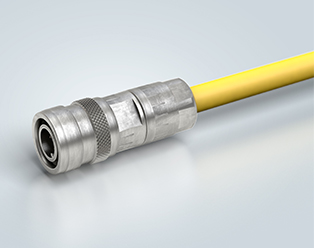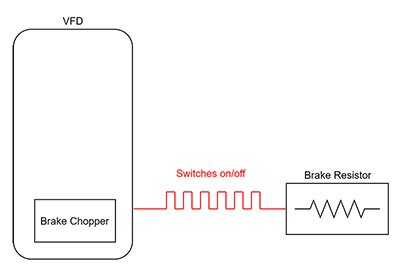Circular Connectors – A Round Thing

April 30, 2019
Jonas Diekmann, Technical Editor at HARTING Electronics
The metric system of units was introduced for the first time in 1793 during the French Revolution and is used even today in almost all countries worldwide. The metric round plug connectors are also based on this system of units and are a known standard in raw industrial applications. In various diameters and codes, they are a reliable connection for the three lifelines of industrial applications. Data, signals and performance are essential for drive, control and communication. The typical round appearance with the thread for screwing in is a success story up to the present. But classics often also still reveal unexpected potential. With its new PushPull Locking and Com-Lock HARTING is making two round guild models ready for the future.
An overview of tested principles and new technologies.
Metric round plug connectors are some of the most widespread interfaces worldwide, when it comes to cabling for machines, industrial plant and devices under demanding conditions of use. They originated in design of their locking, which relies on the dimensions and standardisation of screws that match ISO 1502. So metric round plug connectors in the area of locking always have firmly defined diameters in millimetres, as all standard screw connections have. M8 = 8 millimetres etc.
Widespread sizes in this category that have established themselves in the largest numbers worldwide are M8 and M12. Besides this there are still connections in the metric size M23. If we leave the area of metric sizes, there are still the quite widespread round plug connector in the 7/8-inch size. This often aids transmission of supply voltages not previously achieved using smaller plug connectors.
The three lifelines
Round plug connectors can most easily be subdivided by area of application, in other words by the lifelines they bring into the device. These are classically:
- Data on ethernet protocol basis for communication with up to 10 Gbit/s
- Signals for I/O communication and control of sensors
- Performance for the voltage supply of applications, control, drive and Co.
Data
In the area of data transmission for coding in line with IEC 61076-2-114 the small, space-saving M8 plug connector is available. HARTING has been carrying the ethernet-enabled M8 since 2016 under the umbrella of the “Little Giants” campaign for miniaturised ethernet interfaces and their own signature Miss M8ty. This shows the advantages of the miniaturised interface, such as PoE, end-to-end shielding for EMV and protection against dust and liquids in line with IP Standard 65/67.
If you are looking for round plug connectors for ethernet that are as small as possible, the M8 D-coded is the right choice.
In P-coding the market offers an ethercat-enabled M8 interface, which like D-coding with PoE can transmit power in addition to data.
In addition to D-coding in the M12 area it is particularly X-coding that plays a significant role in data transfer with its pregnant connector face, which is always easily recognised with the X-shaped shielding plate in the connector face as a fast ethernet interface for up to 10Gbit/s. It is standardised in line with IEC 61076-2-109 and is the right choice, when it comes to broadband transmission, as is necessary for modern high-definition camera applications and central transmission paths. It is exactly small and space-saving applications such as new industrial cameras that offer little space for multiple interfaces. This is where X-coding comes into its own, since it can also transmit power over ethernet. If top performance is not the main thing, it is also possible to opt for the metric 12th in D-coding in line with IEC 61076-2-101.
 If you take the next step to the markedly larger M23 interface, data transmission is available only in combination with signals and power. This hybrid solution makes sense in that such a large interface only for data transmission would require an unnecessarily large space. So it is directly combined with four power and signal contacts and transmits all lifelines in one connector face.
If you take the next step to the markedly larger M23 interface, data transmission is available only in combination with signals and power. This hybrid solution makes sense in that such a large interface only for data transmission would require an unnecessarily large space. So it is directly combined with four power and signal contacts and transmits all lifelines in one connector face.
Signals
The M8 in A- and B-coding in line with IEC 61076-2-104 transmits signals up to 100Mbit/s as classic I/O signal interface for small sensors. A-coding is responsible for sensor and actor signals and can in the process also transmit up to 4A transmission. In all cases where it is a matter of the IP65/67 protected transmission of signals, it is a good solution for saving space.
In the same field we see the M12 with A- and B-coding. This complies with norm IEC 61076-2-101 and is basically the larger and rather more robust variant of the M8 for signals. Both are probably most frequently used on sensor/actor boxes and here create a connection to the sensor system.
The largest representative of signal-transmitting plug connectors here is the M23. In its robust metal housing, the user can decide between uses with numbers of contacts of 6-19 pins.
Power
Without a suitable voltage supply nothing functions. No machine, drive or control is any use without the power lifeline. So, energy-guzzling applications noticeably shrink and require a small and concurrently high-performance interface. Whereas previously 7/8“ interfaces were widespread and common in voltage supply, now new M12 codings are taking over this task. Standard in IEC 61076-2-111 are the codings K, L, M, S, T, E and F. The models most widely available are currently the codings K and L. Whereas the L-coding uses four contacts and a FE 63V at 16A predominantly for PROFINET applications, the new K-coding with 630V at 12A is an efficient introduction for all applications in the area of electricity drives. Also, for sensor/actor boxes the M12 Power is an important innovation. Until now boxes have generally been designed with various M12 interfaces plus a 7/8“ interface. This is significantly larger and exceeds the otherwise uniform form factor. Now with power supply via M12 all interfaces can be designed similarly, thus saving space.
If there is still a need for more, the M23 is again in the running. Here 5 power contacts and a PE up to 630V at 28A take care of the required performance. So, it is possible to transmit high performance in confined installation spaces.
Locking
The locking of industrially-used plug connectors is arguably the most important factor in an interface. Firstly, safe and robust locking creates the electric connection and secures it against shock, vibration, foreign bodies, liquids and external radiation. In the industrial field the reliability of a connection means the difference between smooth, predictable and cost-efficient production and unplanned down-time and incalculable costs. Interfaces for data, signal and power might at first sight only seem like insignificant small parts, but when it comes down to it, a whole production line depends on the faultless operation of these lifelines.
As described at the beginning, in the area of round plug connectors the classic locking of screw locks is achieved with metric thread. It creates an extremely robust and IP65/67 protected connection. The drawback to this technology is assembly time and the space required for tools to adjust the correct tightening torque.
Even in this area HARTING offers an innovative solution at the right time.
In this area of round plug connectors HARTING offers PushPull technology, which locks in seconds without the need for tools and with a loud click. It saves up to 70% assembly time compared with previous screw locks and can also be operated by trained staff fast and safely and offers the same or even higher resistance against external influences. Insert, click and the connection is in place and can be reversed simply by taking the locking ring and pulling to break the connection.
For M23 this fast locking alternative is called Comfortable-Lock, Com-Lock for short, and locking takes place with a quarter turn of the retaining ring. This principle is reminiscent of bayonet locks, and it is just as quick and simple to use. In the market this trend towards quick and simple technologies can clearly be seen. Saving assembly time means a cost saving for installers and work simplification for assembly staff.
Connection technologies
By “connection technology” here we mean not the connection of plugs to a socket, but rather connection of the cable to plug connectors. Even this transition is a sensitive topic, in particular for data and power connections. Data transmission calls for shielding against crosstalk, return loss and external radiation, and in voltage supply cable diameter and temperatures via transition resistances play an important role.
Common connection technologies in the area of round plug connectors are crimp connectors, in which the copper conductor is pressed into a metal housing, the goal always being an electricity-conducting, gasproof connection. Crimp connectors are very reliable and robust connections, provided the crimping is carried out properly.
For round plug connectors connected in the field, which, for example when constructing a service road, can only be connected to a suitably shortened cable, insulation displacement connectors are used. In the area of M12 plug connectors HARTING uses the patented HARAX insulation displacement connector, which is marked by quick and simple use and a secure connection. This connection is resistant against shock and vibration and is also a solid, gas-proof connection for stranded and single lines. A further technology is locking, in which the conductor is tightened with clamp and screw.
On the device side sockets are generally connected using various soldering techniques. Here HARTING offers solutions for wave soldering devices and reflow soldering devices. In large M23 models conductors can be welded into prepared cases.






